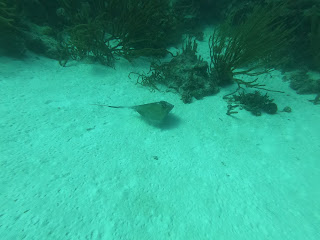Invisibles
The dive site was called Invisibles. We chose it because it has an easy entry and a double reef. If you're ambitious and curious, you can swim over the reef crest to the seaward side and explore down as deep as you dare.
 |
| An Atlantic stingray, Dasyatis sabina |
We headed further away from shore, pushed ourselves up over the reef crest, and descended down the back side of the double reef. My heart pounded a little harder as I contemplated where I was. Slowly, carefully, we descended to a maximum depth of 45 m (150 ft), to the very bottom of the coral reef. Species dropped off one by one until the community was sparse and largely sponge-dominated. Eventually, the coral heads disappeared altogether, and reef gave way to a sandy slope. This must be where the light gets too dim for corals to photosynthesize.
Having reached the very edge of Bonaire's barrier reef, we turned and headed slowly back upward. Just a few minutes later, my husband turned and gestured wildly to me. He had found a massive sea cucumber! The species usually has a prominent red band around its body, but in the dim light, it looked dull gray to us. Red light penetrates very poorly in seawater, and at our depth, it was undetectable to the human eye.
Further we swam until we reached a gap in the reef. Dozens of green hooks emerged from the white sandy tract in front of us. I pushed myself forward to investigate. One of the key advantages of rebreather diving is that I am largely silent underwater. No loud bubbles spew from my regulator, so wildlife are unafraid. I brought my face as close to the green hooks as I could without hitting the sand, and they began to slowly withdraw. I may not make noise, but I still cast a shadow. Dozens of eyes stared back at me as the garden eels sheepishly sank into their burrows. As I reached their colony, I backed away from the seafloor - no need to scare the eels today.
 |
| Lionfish, Pterois volitans |
The last find of the day was a lionfish. They're invasive in the Caribbean, but recent years have seen a dramatic, wide-spread effort to eradicate them. Some divers hunt lionfish with spears, and many restaurants serve the meat. Nowadays, you'd be hard-pressed to find a lionfish above 20 m deep (60 ft). We found one lone, small lionfish hunkering under a rock on the outer reef.
After a decompression stop, we returned to the surface. It was a great dive at Invisibles.

Comments
Post a Comment